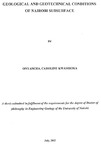| dc.description.abstract | The City of Nairobi is the capital as well as the social, economic and communication hub of Kenya. It is located on the eastern flank of the East African Rift Valley. The study area is mainly underlain by pyroclastic volcanic rocks intercalated with sediments that were deposited in a large lake or series of lakes that extended from 01 Doinyo Sabuk to almost Kajiado. Owing to the geologic origin, the Nairobi subsurface is not homogeneous.
Constructors have reported variable subsoil at building sites, defects in structures that can be related to foundation conditions or adjacent excavation and groundwater flow into excavations and basements. There is also fear that the extensive groundwater extraction could result in depletion of aquifers and eventually cause surface subsidence. The main objective of this study was to investigate the geological and geotechnical characteristics of the subsurface materials and recommend areas where shoring and underpinning works are required to safeguard against effects of ground movement, sensitive and variable subsoil and groundwater drawdown.
Primary data was collected through standard methods of data collection. This included observation and sample collection from construction sites, investigation of causes of distress in structures, core logging of geotechnical and water supply boreholes drilled during the period' of study and geophysical resistivity survey. Geophysical resistivity surveys were carried out to relate geoelectric properties to mechanical properties using various formulae obtained from experimental studies elsewhere. The electrical sounding was in most cases carried out adjacent to boreholes to compare the subsurface profile with the geophysical properties.
Secondary data was obtained from archival records and reports, structural designs, publications and conference papers as well as from people who previously carried out work in the study area. The secondary data includes data on geology, rainfall, hydrogeology, earthquakes, structural foundation design, shoring and underpinning operations and geotechnical and failure investigations.
In the analysis, the geological map, rivers and contours were digitized for use in GIS; spatial and temporal rest level variations were analysed using Surfer and GIS software packages. Subsurface profiles for various localities were plotted using Strater software and probable settlements were calculated. Fractures were traced using borehole logs and Didger software. The following geotechnical properties were analysed: grading; consistency; expansion and collapse; direct shear and triaxial shear; consolidation; bearing capacity and allowable pressures.
The study concluded the following: groundwater rest levels have dropped with an average of 73 m in the last 80 years and estimated settlement of 0.034 m to 5.9 mcould result from groundwater depletion from aquifers and clay aquitards over a long period of time; there seems to have been many centres of volcanic activity during formation of Kerichwa Valley Series leading to formation of materials with variable geotechnical properties; variable subsoil at construction sites and in adjacent boreholes can be related to fractures that are concealed by swamp soils and deep alluvium; the geologic materials have been insufficiently characterised by geotechnical data but the gaps in knowledge were bridged by analysis of logs recovered from water supply wells; the engineering properties of the soils vary widely and are related to the parent material; the difference in bearing capacities of weathered and fresh rock ranges between 10 and 30 times; the allowable pressures on the subsoil range between 0 kN/m2 to 26537 kN/m2 while the design pressures range between 0 kN/m2 and 6000 kN/m2 ; Weathered/decomposed tuffs, agglomeratic tuffs, silty clays and red clays are liable to collapse in excavations; Distress is common in structures supported on concealed fractures, moisture sensitive soils, thin! variable
laterites, fill and inclined profiles.
The study recommends the following: Drilling of monitoring boreholes in the vicinity of meteorological stations to estimate natural recharge and determine safe yield for the purpose of controlling rest level falls; installation of a few real-time settlement meters to monitor sites with high yielding wells and areas with potential of large settlements; use of two-dimensional tomography to further investigate the presence of concealed fractures and for routine site investigations; shoring and/or underpinning operations when making vertical cuts adjacent to existing shallow foundations to control movements; and, use of the successful construction and shoring/underpinning methods discussed here to mitigate distress in structures. It also recommends serious attention to the conditions of the subsoil before structures are constructed to avoid potential of hazards and disasters in the construction industry like what has been experienced in Nairobi in the last few years. | en_US |

